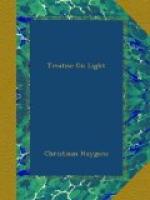Now to say what these waves become after the rays have begun to cross one another: it is that from thence they fold back and are composed of two contiguous parts, one being a curve formed as evolute of the curve ENC in one sense, and the other as evolute of the same curve in the opposite sense. Thus the wave KE, while advancing toward the meeting place becomes abc, whereof the part ab is made by the evolute bC, a portion of the curve ENC, while the end C remains attached; and the part bc by the evolute of the portion bE while the end E remains attached. Consequently the same wave becomes def, then ghk, and finally CY, from whence it subsequently spreads without any fold, but always along curved lines which are evolutes of the curve ENC, increased by some straight line at the end C.
There is even, in this curve, a part EN which is straight, N being the point where the perpendicular from the centre X of the sphere falls upon the refraction of the ray DE, which I now suppose to touch the sphere. The folding of the waves of light begins from the point N up to the end of the curve C, which point is formed by taking AC to CX in the proportion of the refraction, as here 3 to 2.
As many other points as may be desired in the curve NC are found by a Theorem which Mr. Barrow has demonstrated in section 12 of his Lectiones Opticae, though for another purpose. And it is to be noted that a straight line equal in length to this curve can be given. For since it together with the line NE is equal to the line CK, which is known, since DE is to AK in the proportion of the refraction, it appears that by deducting EN from CK the remainder will be equal to the curve NC.
Similarly the waves that are folded back in reflexion by a concave spherical mirror can be found. Let ABC be the section, through the axis, of a hollow hemisphere, the centre of which is D, its axis being DB, parallel to which I suppose the rays of light to come. All the reflexions of those rays which fall upon the quarter-circle AB will touch a curved line AFE, of which line the end E is at the focus of the hemisphere, that is to say, at the point which divides the semi-diameter BD into two equal parts. The points through which this curve ought to pass are found by taking, beyond A, some arc AO, and making the arc OP double the length of it; then dividing the chord OP at F in such wise that the part FP is three times the part FO; for then F is one of the required points.
[Illustration]
And as the parallel rays are merely perpendiculars to the waves which fall on the concave surface, which waves are parallel to AD, it will be found that as they come successively to encounter the surface AB, they form on reflexion folded waves composed of two curves which originate from two opposite evolutions of the parts of the curve AFE. So, taking AD as an incident wave, when the part AG shall have met




